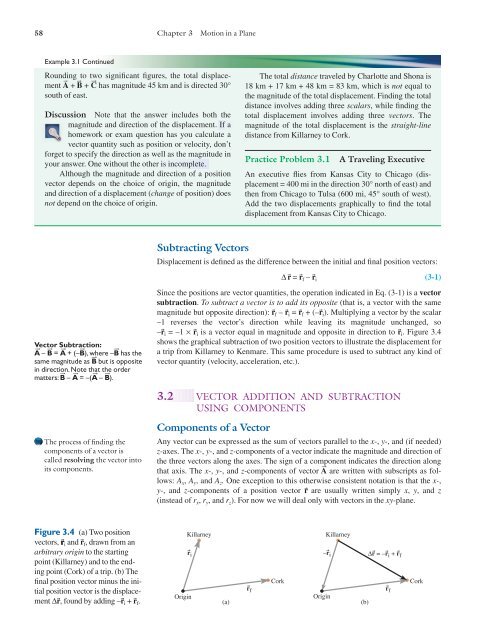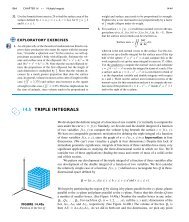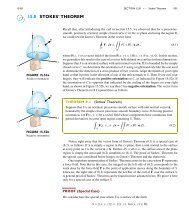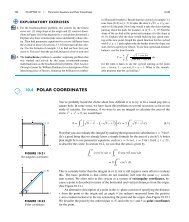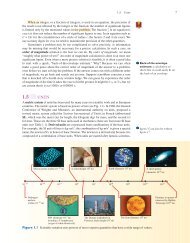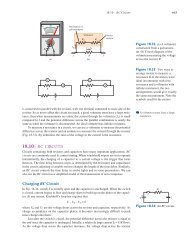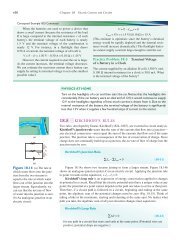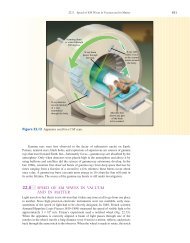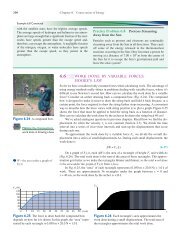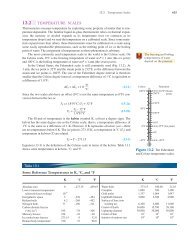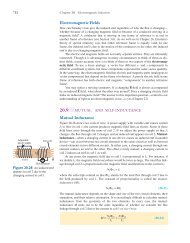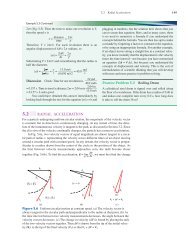Subtracting Vectors Components of a Vector
Subtracting Vectors Components of a Vector
Subtracting Vectors Components of a Vector
You also want an ePaper? Increase the reach of your titles
YUMPU automatically turns print PDFs into web optimized ePapers that Google loves.
58 Chapter 3 Motion in a Plane<br />
Example 3.1 Continued<br />
Rounding to two significant figures, the total displacement<br />
A + B + C has magnitude 45 km and is directed 30°<br />
south <strong>of</strong> east.<br />
Discussion Note that the answer includes both the<br />
magnitude and direction <strong>of</strong> the displacement. If a<br />
homework or exam question has you calculate a<br />
vector quantity such as position or velocity, don’t<br />
forget to specify the direction as well as the magnitude in<br />
your answer. One without the other is incomplete.<br />
Although the magnitude and direction <strong>of</strong> a position<br />
vector depends on the choice <strong>of</strong> origin, the magnitude<br />
and direction <strong>of</strong> a displacement (change <strong>of</strong> position) does<br />
not depend on the choice <strong>of</strong> origin.<br />
The total distance traveled by Charlotte and Shona is<br />
18 km + 17 km + 48 km = 83 km, which is not equal to<br />
the magnitude <strong>of</strong> the total displacement. Finding the total<br />
distance involves adding three scalars, while finding the<br />
total displacement involves adding three vectors. The<br />
magnitude <strong>of</strong> the total displacement is the straight-line<br />
distance from Killarney to Cork.<br />
Practice Problem 3.1<br />
A Traveling Executive<br />
An executive flies from Kansas City to Chicago (displacement<br />
= 400 mi in the direction 30° north <strong>of</strong> east) and<br />
then from Chicago to Tulsa (600 mi, 45° south <strong>of</strong> west).<br />
Add the two displacements graphically to find the total<br />
displacement from Kansas City to Chicago.<br />
<strong>Vector</strong> Subtraction:<br />
A – B = A +(–B ), where –B has the<br />
same magnitude as B but is opposite<br />
in direction. Note that the order<br />
matters: B – A = –(A – B ).<br />
<strong>Subtracting</strong> <strong><strong>Vector</strong>s</strong><br />
Displacement is defined as the difference between the initial and final position vectors:<br />
∆ r = r f – r i (3-1)<br />
Since the positions are vector quantities, the operation indicated in Eq. (3-1) is a vector<br />
subtraction. To subtract a vector is to add its opposite (that is, a vector with the same<br />
magnitude but opposite direction): r f – r i = r f + (–r i ). Multiplying a vector by the scalar<br />
–1 reverses the vector’s direction while leaving its magnitude unchanged, so<br />
–r i =–1× r i is a vector equal in magnitude and opposite in direction to r i . Figure 3.4<br />
shows the graphical subtraction <strong>of</strong> two position vectors to illustrate the displacement for<br />
a trip from Killarney to Kenmare. This same procedure is used to subtract any kind <strong>of</strong><br />
vector quantity (velocity, acceleration, etc.).<br />
3.2 VECTOR ADDITION AND SUBTRACTION<br />
USING COMPONENTS<br />
The process <strong>of</strong> finding the<br />
components <strong>of</strong> a vector is<br />
called resolving the vector into<br />
its components.<br />
<strong>Components</strong> <strong>of</strong> a <strong>Vector</strong><br />
Any vector can be expressed as the sum <strong>of</strong> vectors parallel to the x-, y-, and (if needed)<br />
z-axes. The x-, y-, and z-components <strong>of</strong> a vector indicate the magnitude and direction <strong>of</strong><br />
the three vectors along the axes. The sign <strong>of</strong> a component indicates the direction along<br />
that axis. The x-, y-, and z-components <strong>of</strong> vector A are written with subscripts as follows:<br />
A x , A y , and A z . One exception to this otherwise consistent notation is that the x-,<br />
y-, and z-components <strong>of</strong> a position vector r are usually written simply x, y, and z<br />
(instead <strong>of</strong> r x , r y , and r z ). For now we will deal only with vectors in the xy-plane.<br />
Figure 3.4 (a) Two position<br />
vectors, r i and r f , drawn from an<br />
arbitrary origin to the starting<br />
point (Killarney) and to the ending<br />
point (Cork) <strong>of</strong> a trip. (b) The<br />
final position vector minus the initial<br />
position vector is the displacement<br />
∆r, found by adding –r i + r f .<br />
Origin<br />
Killarney<br />
r i<br />
(a)<br />
r f<br />
Cork<br />
Killarney<br />
–r i ∆r = –r i + r f<br />
r f<br />
Origin<br />
(b)<br />
Cork
3.2 <strong>Vector</strong> Addition and Subtraction Using <strong>Components</strong> 59<br />
<strong>Components</strong> <strong>of</strong> vectors were introduced in Chapter 2, but only in cases where the<br />
vectors were all parallel to a single axis. If a vector lies in the xy-plane but is not parallel<br />
to either axis, then both its x- and y-components are nonzero.<br />
Consider the velocity vector v in Fig. 3.5. We can think <strong>of</strong> v as the sum <strong>of</strong> two vectors,<br />
one parallel to the x-axis and the other parallel to the y-axis. The magnitudes <strong>of</strong><br />
these two vectors are the magnitudes (absolute values) <strong>of</strong> the x- and y-components <strong>of</strong> v.<br />
We can find the magnitudes <strong>of</strong> the components using the right triangle in Fig. 3.5 and the<br />
trigonometric functions in Fig. 3.6. The length <strong>of</strong> the arrow represents the magnitude <strong>of</strong><br />
the vector (v = 9.4 m/s), so<br />
adjacent<br />
cos 58° = = v hy potenuse<br />
v x opposite<br />
and sin 58° = = v y<br />
hy potenuse<br />
v<br />
<br />
Now we must determine the correct algebraic sign for each <strong>of</strong> the components.<br />
From Fig. 3.5, the vector along the x-axis points in the positive x-direction and the vector<br />
along the y-axis points in the negative y-direction, so in this case,<br />
v x = +v cos 58° = 5.0 m/s and v y = –v sin 58° = –8.0 m/s<br />
Using the right triangle in Fig. 3.7 gives the same values for the x- and y-components <strong>of</strong><br />
v since cos 32° = sin 58° and sin 32° = cos 58°.<br />
y<br />
58°<br />
v x<br />
v<br />
v y<br />
Figure 3.5 Resolving a<br />
velocity vector v into x- and<br />
y-components.<br />
x<br />
Problem-Solving Strategy: Finding the x- and y-<strong>Components</strong> <strong>of</strong> a <strong>Vector</strong><br />
from Its Magnitude and Direction<br />
1. Draw a right triangle with the vector as the hypotenuse and the other two sides<br />
parallel to the x- and y-axes.<br />
2. Determine one <strong>of</strong> the unknown angles in the triangle.<br />
3. Use trigonometric functions to find the magnitudes <strong>of</strong> the components. Make<br />
sure your calculator is in “degree mode” to evaluate trigonometric functions <strong>of</strong><br />
angles in degrees and “radian mode” for angles in radians.<br />
4. Determine the correct algebraic sign for each component.<br />
We must also know how to reverse the process:<br />
b<br />
f<br />
90°<br />
Right triangle<br />
c<br />
q<br />
a<br />
f = 90° – q<br />
Problem-Solving Strategy: Finding the Magnitude and Direction <strong>of</strong> a <strong>Vector</strong><br />
Afrom Its x- and y-<strong>Components</strong><br />
1. Sketch the vector on a set <strong>of</strong> x- and y-axes in the correct quadrant, according to<br />
the signs <strong>of</strong> the components.<br />
2. Draw a right triangle with the vector as the hypotenuse and the other two sides<br />
parallel to the x- and y-axes.<br />
3. In the right triangle, choose which <strong>of</strong> the unknown angles you want to determine.<br />
4. Use the inverse tangent function to find the angle. The lengths <strong>of</strong> the sides <strong>of</strong> the triangle<br />
represent A x and A y . If q is opposite the side parallel to the x-axis, then<br />
tan q = opposite/adjacent = A x /A y . If q is opposite the side parallel to the y-axis,<br />
then tan q = opposite/adjacent = A y /A x . If your calculator is in “degree mode,” then<br />
the result <strong>of</strong> the inverse tangent operation will be in degrees. [In general, the inverse<br />
tangent has two possible values between 0 and 360° because tan a = tan (a + 180°).<br />
However, when the inverse tangent is used to find one <strong>of</strong> the angles in a right triangle,<br />
the result can never be greater than 90°, so the value the calculator returns is the<br />
one you want.]<br />
5. Interpret the angle: specify whether it is the angle below the horizontal, or the<br />
angle west <strong>of</strong> south, or the angle clockwise from the negative y-axis, etc.<br />
6. Use the Pythagorean theorem to find the magnitude <strong>of</strong> the vector.<br />
A = A 2 x + A<br />
2 y<br />
sin q = ______________<br />
side opposite ∠q<br />
= _ b<br />
hypotenuse c<br />
cos q = ______________<br />
side adjacent ∠q<br />
= _ a<br />
hypotenuse c<br />
tan q = ______________<br />
side opposite ∠q<br />
= _ b<br />
side adjacent ∠q a<br />
Figure 3.6 Trigonometric<br />
functions (see Appendix A.7 for<br />
more information).<br />
y<br />
32°<br />
v y<br />
v x<br />
v<br />
Figure 3.7 Resolving the<br />
velocity vector into components<br />
using a different right triangle.<br />
x
60 Chapter 3 Motion in a Plane<br />
Suppose we knew the components <strong>of</strong> the velocity vector in Fig. 3.5, but not the<br />
magnitude and direction. Let us find the angle q between v and the +x-axis:<br />
q = tan –1 o pposite<br />
= tan –1 v y<br />
= tan –1 8 . 0 m/<br />
s<br />
= 58°<br />
adjacent<br />
v<br />
5.<br />
0 m/<br />
s<br />
The magnitude <strong>of</strong> v is<br />
v = v 2 2<br />
x + v y = (+5.0 /s) m–8.0 2 + ( /s) m 2 = 9.4 m/s<br />
x<br />
Adding <strong><strong>Vector</strong>s</strong> Using <strong>Components</strong><br />
It is generally easier and more accurate to add vectors algebraically rather than graphically.<br />
The algebraic method relies on adding the components <strong>of</strong> the vectors. Remember<br />
that each vector is thought <strong>of</strong> as the sum <strong>of</strong> vectors parallel to the axes (Fig. 3.8a). When<br />
adding vectors, we can add them in any order and group them as we please. So we can<br />
sum the x-components to find the x-component <strong>of</strong> the sum (Fig. 3.8b) and then do the<br />
same with the y-components (Fig. 3.8c):<br />
C = A + B if and only if C x = A x + B x and C y = A y + B y (3-2)<br />
In Eq. (3-2), remember that A x + B x represents ordinary addition since the signs <strong>of</strong> the<br />
components carry the direction information.<br />
Problem-Solving Strategy: Adding <strong><strong>Vector</strong>s</strong> Using <strong>Components</strong><br />
1. Find the x- and y-components <strong>of</strong> each vector to be added.<br />
2. Add the x-components (with their algebraic signs) <strong>of</strong> the vectors to find the x-<br />
component <strong>of</strong> the sum. (If the signs are not correct, the sum will not be correct.)<br />
3. Add the y-components (with their algebraic signs) <strong>of</strong> the vectors to find the y-<br />
component <strong>of</strong> the sum.<br />
4. If necessary, use the x- and y-components <strong>of</strong> the sum to find the magnitude and<br />
direction <strong>of</strong> the sum.<br />
Even when using the component method to add vectors, the graphical method is an<br />
important first step. A rough sketch <strong>of</strong> vector addition, even one made without carefully<br />
measuring the lengths or the angles, has important benefits. Sketching the vectors makes it<br />
much easier to get the signs <strong>of</strong> the components correct. The graphical addition also serves<br />
as a check on the answer—it provides an estimate <strong>of</strong> the magnitude and direction <strong>of</strong> the<br />
sum, which can be used to check the algebraic answer. Graphical addition gives you a<br />
mental picture <strong>of</strong> what is going on and an intuitive feel for the algebraic calculations.<br />
B x<br />
(a) (c)<br />
A x<br />
B x<br />
A x<br />
Figure 3.8 (a) C = A + B,<br />
shown graphically with the x-<br />
and y-components <strong>of</strong> each vector<br />
illustrated. (b) C x = A x + B x ;<br />
(c) C y = A y + B y .<br />
B<br />
C x<br />
y<br />
B<br />
A A y<br />
C = A + B<br />
C y<br />
B y<br />
C y<br />
A y<br />
C x<br />
(b)
3.2 <strong>Vector</strong> Addition and Subtraction Using <strong>Components</strong> 61<br />
Choosing x- and y-Axes<br />
A problem can be made easier to solve with a good choice <strong>of</strong> axes. We can choose any<br />
direction we want for the x- and y-axes, as long as they are perpendicular to each other.<br />
Three common choices are<br />
• x-axis horizontal and y-axis vertical, when the vectors all lie in a vertical plane;<br />
• x-axis east and y-axis north, when the vectors all lie in a horizontal plane; and<br />
• x-axis parallel to an inclined surface and y-axis perpendicular to it.<br />
Example 3.2<br />
An Irish Adventure (2)<br />
In the trip <strong>of</strong> Example 3.1, Charlotte and Shona drive at a<br />
compass heading <strong>of</strong> 27° west <strong>of</strong> south for 18 km to<br />
Kenmare, then directly south for 17 km to Glengariff, then<br />
at a compass heading <strong>of</strong> 13° north <strong>of</strong> east for 48 km to<br />
Cork. Use the component method to find the magnitude<br />
and direction <strong>of</strong> the displacement vector for the entire trip.<br />
Strategy As before, let’s call the three successive displacements<br />
A, B, and C, respectively. To add the vectors<br />
using components, we first choose directions for the x-<br />
and y-axes. Then we find the x- and y-components <strong>of</strong> the<br />
three displacements. Adding the x- or y-components <strong>of</strong><br />
the three displacements gives the x- or y-component <strong>of</strong> the<br />
total displacement. Finally, from the components we find<br />
the magnitude and direction <strong>of</strong> the total displacement.<br />
Solution A good choice is the conventional one: x-<br />
axis to the east and the y-axis to the north. The first displacement<br />
( A) is directed 27° west <strong>of</strong> south. Both <strong>of</strong> its<br />
components are negative since west is the –x-direction<br />
and south is the –y-direction. Using the triangle in<br />
Fig. 3.9, the side <strong>of</strong> the triangle opposite the 27° angle is<br />
parallel to the x-axis. The sine function relates the opposite<br />
side to the hypotenuse:<br />
A x = –A sin 27° = –18 km × 0.454 = –8.17 km<br />
where A is the magnitude <strong>of</strong> A. The cosine relates the<br />
adjacent side to the hypotenuse:<br />
A y = –A cos 27° = –18 km × 0.891 = –16.0 km<br />
Displacement B has no x-component since its direction<br />
is south. Therefore,<br />
B x = 0 and B y = –17 km<br />
The direction <strong>of</strong> C is 13° north <strong>of</strong> east. Both its components<br />
are positive. From Fig. 3.9, the side <strong>of</strong> the triangle<br />
opposite the 13° angle is parallel to the y-axis, so<br />
y<br />
A = 18 km 27° B = 17 km C = 48 km<br />
A A<br />
C<br />
y<br />
B<br />
13°<br />
C y<br />
x<br />
A x<br />
C x<br />
Figure 3.9<br />
Resolving A, B, and C into x- and y-components.<br />
C x = +C cos 13° = +48 km × 0.974 = +46.8 km<br />
C y = +C sin 13° = +48 km × 0.225 = +10.8 km<br />
Now we sum the x- and y-components separately to<br />
find the x- and y-components <strong>of</strong> the total displacement:<br />
∆x = C x + B x + A x<br />
= 46.8 km + 0 + (–8.17 km) = +38.63 km<br />
∆y = C y + B y + A y<br />
= 10.8 km + (–17 km) + (–16.0 km) = –22.2 km<br />
The magnitude and direction <strong>of</strong> ∆r can be found from<br />
the triangle in Fig. 3.10. The magnitude is represented by<br />
the hypotenuse:<br />
∆r = (∆x) 2 + (∆y) 2 = (38.63 km) 2 + (–22.2km) 2<br />
= 45 km<br />
The angle q is<br />
q = tan –1 o pposite<br />
= tan –1 22.<br />
2 km<br />
= 30°<br />
adjacent<br />
3 8.<br />
63<br />
km<br />
Since +x is east and –y is<br />
south, the direction <strong>of</strong> the<br />
displacement is 30° south<br />
<strong>of</strong> east. The magnitude<br />
and direction <strong>of</strong> the displacement<br />
found using<br />
components agree with<br />
the displacement found<br />
graphically in Fig. 3.3.<br />
Discussion Note that the x-component <strong>of</strong> one displacement<br />
was found using the sine function while another was<br />
found using the cosine. The x-component (or the y-<br />
component) <strong>of</strong> the vector can be related to either the sine or<br />
the cosine, depending on which angle in the triangle is used.<br />
Practice Problem 3.2<br />
Coordinate Axes<br />
38.63 km<br />
θ<br />
22.2 km<br />
Changing the<br />
Find the x- and y-components <strong>of</strong> the displacements for<br />
the three legs <strong>of</strong> the trip if the x-axis points south and the<br />
y-axis points east.<br />
y<br />
∆r<br />
Figure 3.10<br />
Finding the magnitude and<br />
direction <strong>of</strong> ∆r.<br />
x


